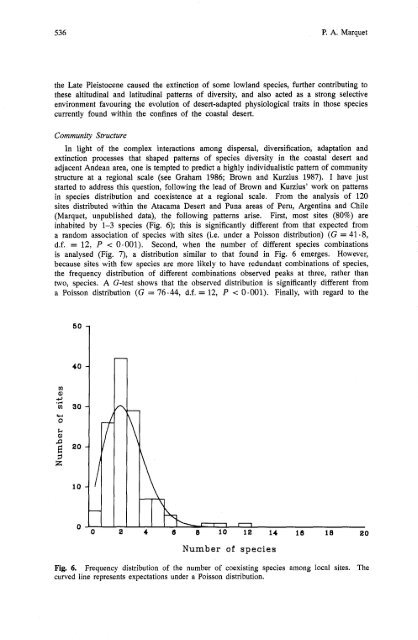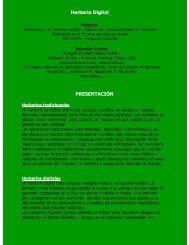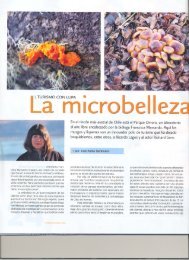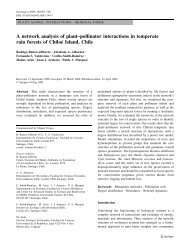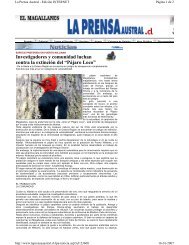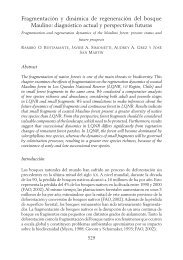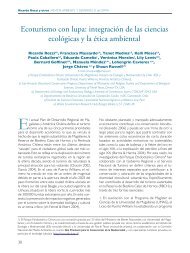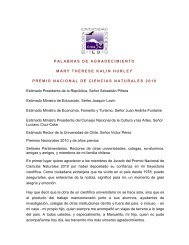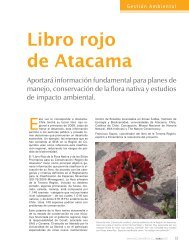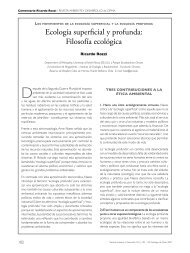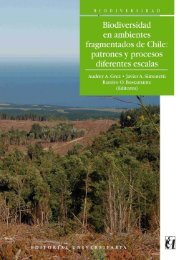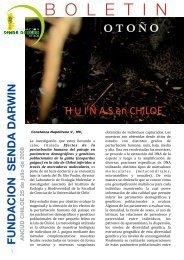Diversity of Small Mammals in the Pacific Coastal Desert of Peru ...
Diversity of Small Mammals in the Pacific Coastal Desert of Peru ...
Diversity of Small Mammals in the Pacific Coastal Desert of Peru ...
Create successful ePaper yourself
Turn your PDF publications into a flip-book with our unique Google optimized e-Paper software.
P. A. Marquet<strong>the</strong> Late Pleistocene caused <strong>the</strong> ext<strong>in</strong>ction <strong>of</strong> some lowland species, fur<strong>the</strong>r contribut<strong>in</strong>g to<strong>the</strong>se altitud<strong>in</strong>al and latitud<strong>in</strong>al patterns <strong>of</strong> diversity, and also acted as a strong selectiveenvironment favour<strong>in</strong>g <strong>the</strong> evolution <strong>of</strong> desert-adapted physiological traits <strong>in</strong> those speciescurrently found with<strong>in</strong> <strong>the</strong> conf<strong>in</strong>es <strong>of</strong> <strong>the</strong> coastal desert.Community StructureIn light <strong>of</strong> <strong>the</strong> complex <strong>in</strong>teractions among dispersal, diversification, adaptation andext<strong>in</strong>ction processes that shaped patterns <strong>of</strong> species diversity <strong>in</strong> <strong>the</strong> coastal desert andadjacent Andean area, one is tempted to predict a highly <strong>in</strong>dividualistic pattern <strong>of</strong> communitystructure at a regional scale (see Graham 1986; Brown and Kurzius 1987). I have juststarted to address this question, follow<strong>in</strong>g <strong>the</strong> lead <strong>of</strong> Brown and Kurzius' work on patterns<strong>in</strong> species distribution and coexistence at a regional scale. From <strong>the</strong> analysis <strong>of</strong> 120sites distributed with<strong>in</strong> <strong>the</strong> Atacama <strong>Desert</strong> and Puna areas <strong>of</strong> <strong>Peru</strong>, Argent<strong>in</strong>a and Chile(Marquet, unpublished data), <strong>the</strong> follow<strong>in</strong>g patterns arise. First, most sites (80%) are<strong>in</strong>habited by 1-3 species (Fig. 6); this is significantly different from that expected froma random association <strong>of</strong> species with sites (i.e, under a Poisson distribution) (G = 41.8,d.f. = 12, P < 0.001). Second, when <strong>the</strong> number <strong>of</strong> different species comb<strong>in</strong>ationsis analysed (Fig. 7), a distribution similar to that found <strong>in</strong> Fig. 6 emerges. However,because sites with few species are more likely to have redundant comb<strong>in</strong>ations <strong>of</strong> species,<strong>the</strong> frequency distribution <strong>of</strong> different comb<strong>in</strong>ations observed peaks at three, ra<strong>the</strong>r thantwo, species. A G-test shows that <strong>the</strong> observed distribution is significantly different froma Poisson distribution (G = 76.44, d.f. = 12, P < 0.001). F<strong>in</strong>ally, with regard to <strong>the</strong>Number <strong>of</strong> speciesFig. 6. Frequency distribution <strong>of</strong> <strong>the</strong> number <strong>of</strong> coexist<strong>in</strong>g species among local sites. Thecurved l<strong>in</strong>e represents expectations under a Poisson distribution.


